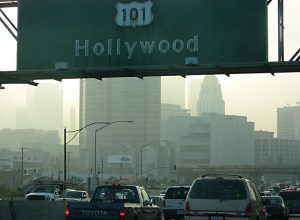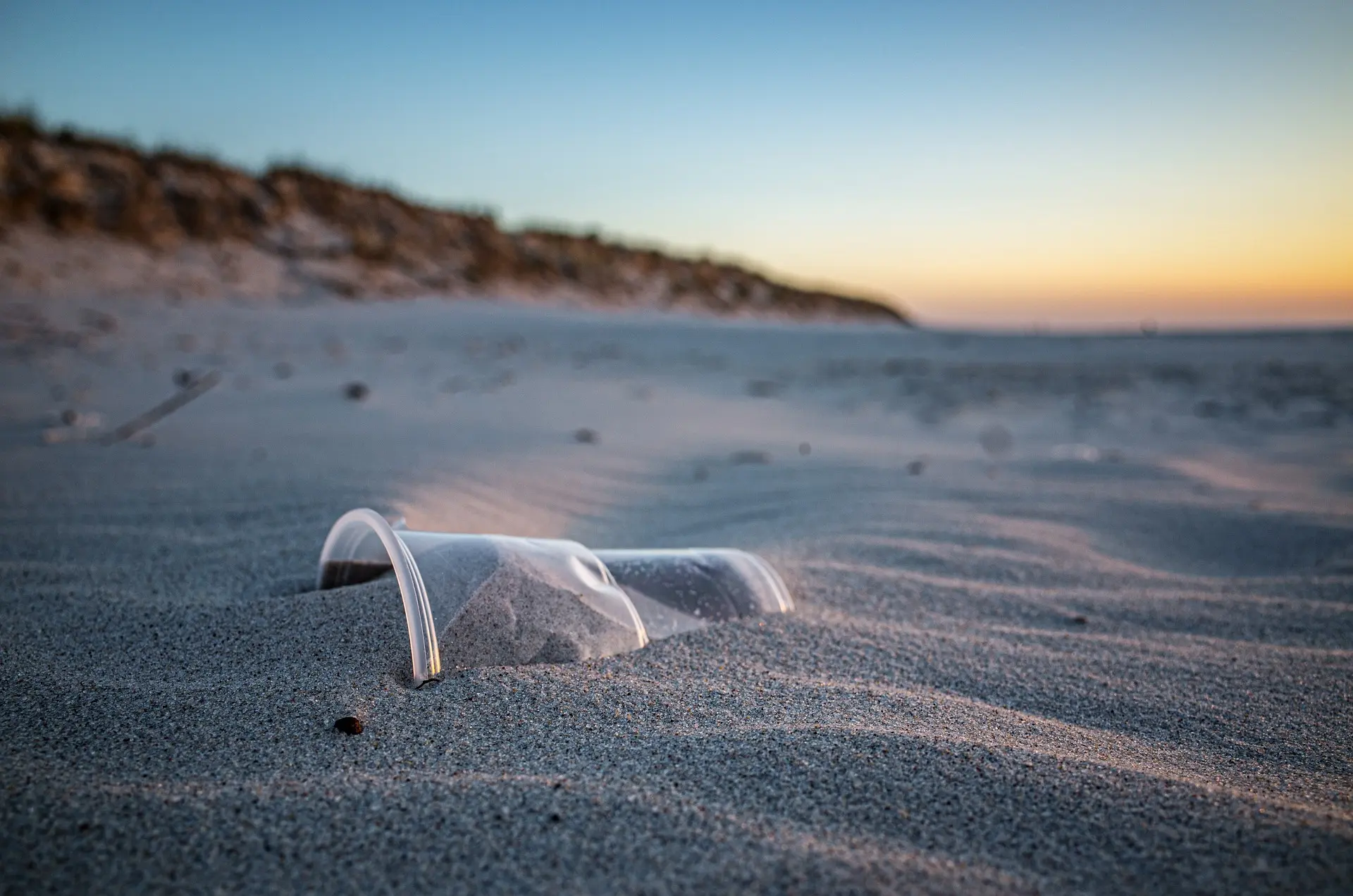Moore and the Algalita
When sailor Charles Moore returned home to California from his boating race in Hawaii, he decided to take a risky shortcut. He brought his vessel, the Algalita, straight across the doldrums. These areas have been considered dangerous by sailors for centuries because lack of wind can leave a ship stranded for weeks. Moore was unafraid, having equipped the Algalita with powerful engines and fuel aplenty.
As he moved over the waters of the gyre, Moore noticed a curious sight. It began with a few floating bits, but soon he found his vessel surrounded by trash. In the many days it took to cross the gyre, plastic hemmed him in. Moore later described the experience: “It seemed unbelievable, but I never found a clear spot. In the week it took to cross the subtropical high, no matter what time of day I looked, plastic debris was floating everywhere.”1
Moore had discovered what we now call the Great Pacific Garbage Patch—20 million square miles comprising the planet’s largest dump. After his return, Moore outfitted the Algalita as a research vessel and spent his entire family fortune to tackle the problem. Seeing as plastic fragments in this area outweigh zooplankton six to one, our efforts to remove them will take generations.2
Even if all the large plastics were removed from the seven seas, microplastics are permanent, since they’ve already worked their way into the food chain and the water table (92% of Americans have harmful plastic in their urine as a result3). Despite the odds, the Algalita presses on and is still in operation today.4

Great Pacific Garbage Patch, L. Lebreton, et. al., CC BY-SA 3.0, via Wikimedia Commons
Contemplating the state of our oceans, and our environment at large, may leave us worried about what will happen to humanity. People across the globe feel concerns about our planet’s condition.5 In some cases, people are experiencing chronic anxiety about the destruction of the earth. Occurrences of these sensations are so common that psychologists now have a term for the condition: eco-anxiety.
What is eco-anxiety? The American Psychological Association defines eco-anxiety as “a chronic fear of environmental doom”.6 This type of anxiety has been cited as a cause of insomnia, exhaustion, depression, and in extreme cases suicide.7 Unfortunately, eco-anxiety research shows this phenomenon particularly affects young people.8,9
Origins of Eco-anxiety
In my experience as a conservation biologist, I see two potential origins of eco-anxiety. In one vein, our fears may be based in truth. Eco-anxiety is a recognition of the fact that our world is changing. Pollution and habitat loss are at an all-time high.10 These observations are undeniable; we experience them daily in the garbage heap down the street or the news report detailing another species gone forever.

US Route 101 entering a smoggy downtown Los Angeles, CC BY-SA 3.0, via Wikimedia Commons
On the other hand, a sense of dread may arise in response to manipulative and unscientific rhetoric. Catastrophizing language is always unhelpful where emotions are already elevated. We must draw from facts first, and feelings second. The sea of media teems with more ideas than the plastic of the North-Pacific gyre; some of these ideas are fact-based and some are not. For instance, one expert recently stated that koalas are now functionally extinct due to the fires in Australia caused by climate change.11 Yet the IUCN12 Redlist labels the koala vulnerable, a full 3 levels less than extinct in the wild. Therefore, the claim that koalas are functionally extinct is categorically false.
Sensationalist statements such as, “The world is going to end in 12 years”13 are severely overblown, if not completely erroneous, because we have yet to see any credible scientific research showing that humanity is on the verge of extinction due to environmental destruction.14 These statements also create major problems for climate scientists, who are working hard to research the problem and publish credible information, only to have their words twisted.15
Given this trend of fact-bending, we should not make the mistake of reacting too far in the other direction. As stewards of God’s creation, we should be concerned about koalas and environmental destruction. There are very real threats to our environment, but there is ample room for hope. In the rising tide of fear, hope offers a solution.
Hope in Truth
It is easier to interject hope where concerns are based on truth rather than falsehood. Hope and truth are inextricably tied. Hebrews 11:1 (ESV) describes faith as “the assurance of things hoped for, the conviction of things not seen.” By faith we understand the mysterious truths of the universe, and our hope backs up these beliefs. When we face fears about the destruction of our environment, we should return to what we know to be true.

Exchange temporal anxieties for eternal hope through the truth of God’s Word.
For instance, when we are told that humanity is in imminent collapse because of its large population, we should come back to the truth that this planet produces much more food than we use.16
We should also stand firm on the Scriptures, remembering that God commanded humanity to multiply and fill the earth and that He created the earth to be inhabited. But we also remember the truth that we are not meant to be reckless, but responsible stewards of the earth, to ‘keep’ what He has made, and that all of nature is ultimately His possession and not ours. These truths all point to a greater promise: the Lord is coming back someday to make all things new. In the light of truth, our eco-anxiety becomes an invitation to participate in the divine restoration that has already begun.
Hope in God’s Grace
We Christians are held to a high standard since we know how precious the earth is in God’s eyes. While it’s good to take stewardship seriously, it’s not good to be so consumed with worrying about doing the wrong thing that we collapse into a heap of anxiety. We are responsible for doing the best we can with what we have.
That includes knowledge. Hosea 4:6 explains this well: “My people are perishing for lack of knowledge. Because you [priests] have rejected knowledge, I also will reject you from being my priests.” A lack of knowledge and rejecting knowledge are two different things. God has grace for us when we act in ignorance.
On the flip side, James 4:17 (NIV) says, “If anyone, then, knows the good they ought to do and doesn’t do it, it is sin for them.” We must be honest before God about the ecological demise we witness and ask ourselves, “what am I capable of doing to change this?” Even in the small things, if we know the right thing to do and don’t do it, it is sin to us.
Hope with Action
True hope is active; it moves us powerfully. As we hope for a better future, we can act hopefully with our everyday lives. Throwing away less trash, eating responsibly-sourced foods, and caring for our environment are all acts of worship, because they show our value of God and His creation.
We also act in our thought-lives. We are not meant to operate out of a spirit of fear, but of power and love and self-control. It takes power to rise above the trap of anxiety, but thanks be to God who has given us sober-minds and self-control! Because of the hope He gives us, we can cast our anxieties on the Prince of Peace, knowing He cares for us.
Hope is the antidote to eco-anxiety. Having hope does not mean that we have side-stepped the problem. We are not burying our heads in the sand. Instead, we face our fears in the light of Christ’s truth. We adorn ourselves in his grace, and march into the darkness with confidence and faith.
The views and opinions expressed in this article are those of the author and do not necessarily reflect the views or positions of Reflections Ministries.
Notes & Citations:
1. Moore, C. Trashed. (November 2003) Natural History Journal.
2. Humes E. (2013). Garbology : our dirty love affair with trash (First trade paperback). Avery a member of Penguin Group (USA), 118.
3. Ibid. 16
4. To learn more about this project, visit https://algalita.org
5. Fagan, M., Huang, C. (April 2019) A look at how people around the world view climate change. Pew Research Center
6. The American Psychological Association first defined this term in 2017.
7. Doherty, T. J., & Clayton, S. (May 2011). The Psychological Impacts of Global Climate Change. American Psychologist, 66(4), 265–276.
8. A recent study, cited as the “largest and most international” survey of climate anxiety in young people aged 16 to 25 to date, revealed that the psychological burdens of eco-anxiety are “profoundly affecting huge numbers of these young people around the world.”
9. Marks E, Hickman C, Pihkala P, et al. Young people’s voices on climate anxiety, government betrayal and moral injury: a global phenomenon. https://ssrn.com/abstract=3918955
10. The average American creates 102 tons of permanent waste, according to the Environmental Protection Agency (EPA). Also, nearly 40% of earth’s ice-free land has been converted to human use, according to Ramankutty N, Evan AT, Monfreda C, Foley JA. (2008). Farming the planet: 1. Geographic distribution of global agricultural lands in the year 2000. Global Biogeochemical Cycles
11. As claimed by Deborah Tabart, chairman of the Koala Foundation.
12. International Union for the Conservation of Nature
13. As stated by representative Alexandria Ocasio-Cortez in an interview with writer Ta-Nehisi Coates
14. Shellenberger, M. (November 2019). Why Apocalyptic Claims about Climate Change are Wrong.
Forbes
15. Ibid.
16. In the USA, for instance, 28 billion pounds of food is thrown away annually. This is 25% of the American food supply. (According to BioCycle/Columbia University)
Additional Articles & Resources:
- Scientific Evidence for God’s Existence (Video with Article)
- The Architecture of Nature (Video)
- Are Faith and Science Compatible? (In Question Video & Transcript)
- The Voyage of Life: Setting Our Hope on Eternity (Video)
- Hope in God (Video)
- What The Bible Says About God’s Word, Audio Series (Store item)



